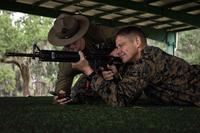Military.com's senior sports correspondent, Michael Hoffman, also occasionally writes about land and expeditionary power, when the service academy college football schedule allows. Here's the dispatch he filed Wednesday from the Surface Navy Association's Marine Corps presentation:
The Marine Corps can’t sacrifice its wholesale modernization plans to budget cuts because another “bow wave” of programs await the Corps in the 2020s, said Lt. Gen. Richard Mills, Marine Corps deputy commandant for combat development and integration.
Marine Corps leaders will look to the president’s new defense strategy for guidance as they proceeds with two of their top modernization priorities, the Amphibious Combat Vehicle and the Joint Light Tactical Vehicle.
Mills said he’s tired of hearing how the Corps “needs to return to ships.” Despite the past ten years fighting mostly ground wars in Iraq and Afghanistan “we’ve never left the ships,” he the Surface Navy Association’s trade show on Wednesday.
The Corps has gotten heavier, though. As it builds the Humvee replacement, the Corps must maintain a mobile, agile force. In his last tour as the Marine Corps’ top officer in Afghanistan, Mills said he saw how many heavy trucks his Marines drive.
That means a top priority is ensuring the JLTV program does not drown under unrealistic requirements, yet remains light. The Corps reached a set of compromises with the Army in a last ditch effort to make the program affordable and avoid Congress’ budget ax.
Corps acquisition officials also remain focused on the ACV program and ensuring it doesn’t meet the same fate as the Expeditionary Fighting Vehicle. Much like the JLTV, Marines can’t allow requirements for the program to spiral out of control in this budget environment.
Setting realistic expectations for its fighting vehicles in light of an evolving battlefield remains a challenge, Mills said. For example, Marine Corps officials must figure out just how far Marines must plan to travel from ship to shore and determine if current combat strategies meet those expectations.
As part of that strategy, the Corps must decide if the force structure review done in 2010 is affordable with the upcoming budget cuts. Marine Corps leaders told Congress that 186,800 troops is a realistic end strength for the Corps. However, budget cuts might force the Corps to cut its force below 180,000.
“Is that the final number? I don’t know,” Mills said. “If not, we’re ready to adjust.”
The Marine Corps must look to grow certain portions of its force despite the future drawdown. Mills listed special operations, cyber warfare, civil affairs, intelligence, route clearance and reconnaissance, military police and unmanned aerial vehicles as areas the Corps needs to expand.
He commended Lockheed Martin’s K-MAX unmanned helicopter and its first flights in Afghanistan as an example of how the Corps can continue to innovate even in the face of the tough budget environment. He said he’s been pleased with reports of the first operations and looks forward to increasing its cargo payload.
"We've had a number of missions flown some in very bad weather ... but we've received very good reports thus far," Mills said.







